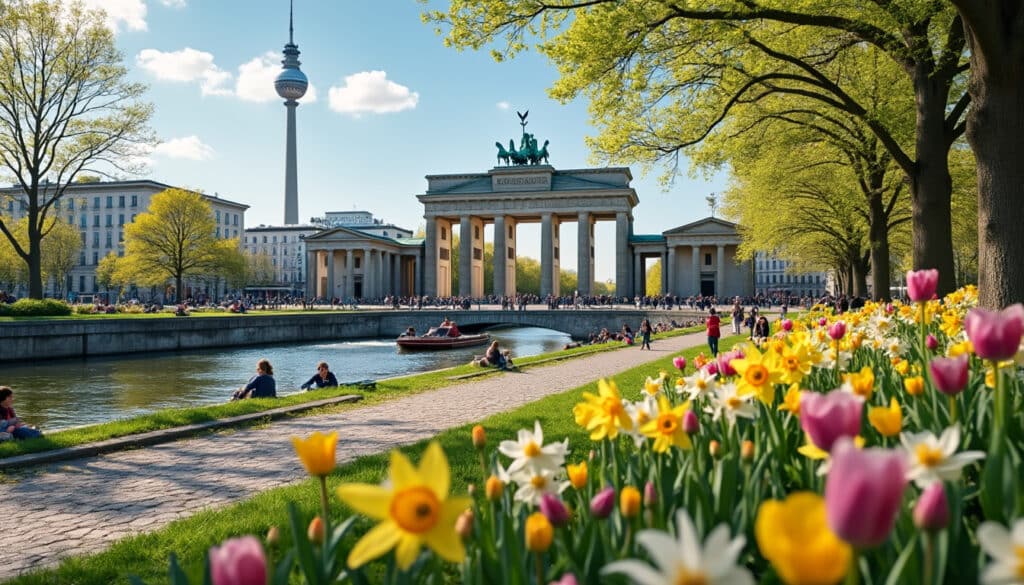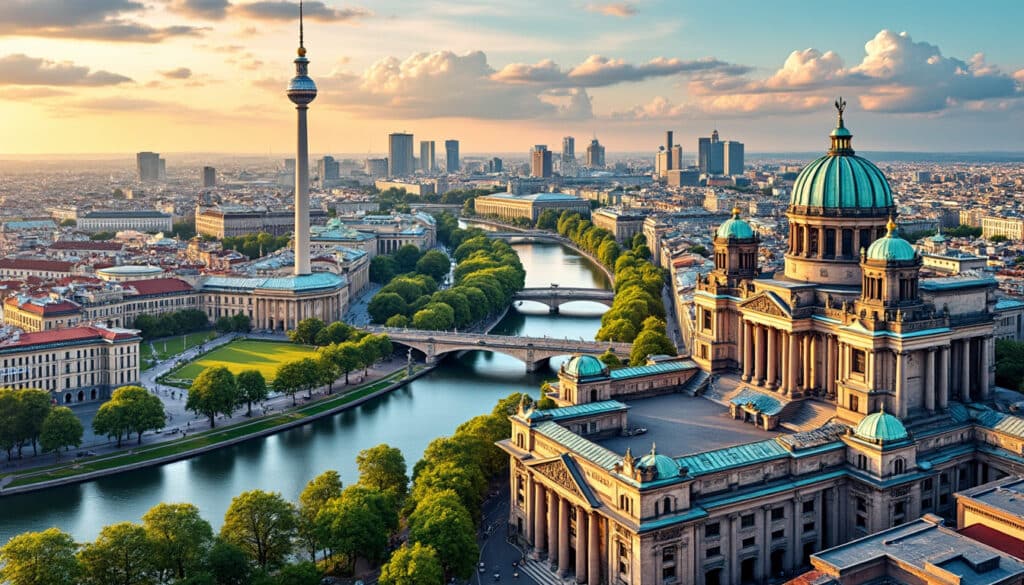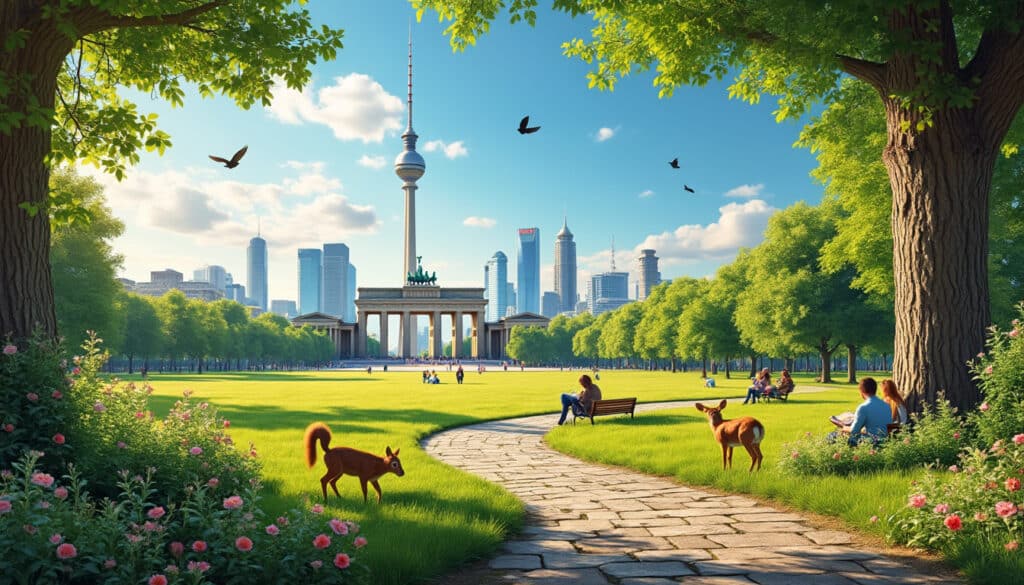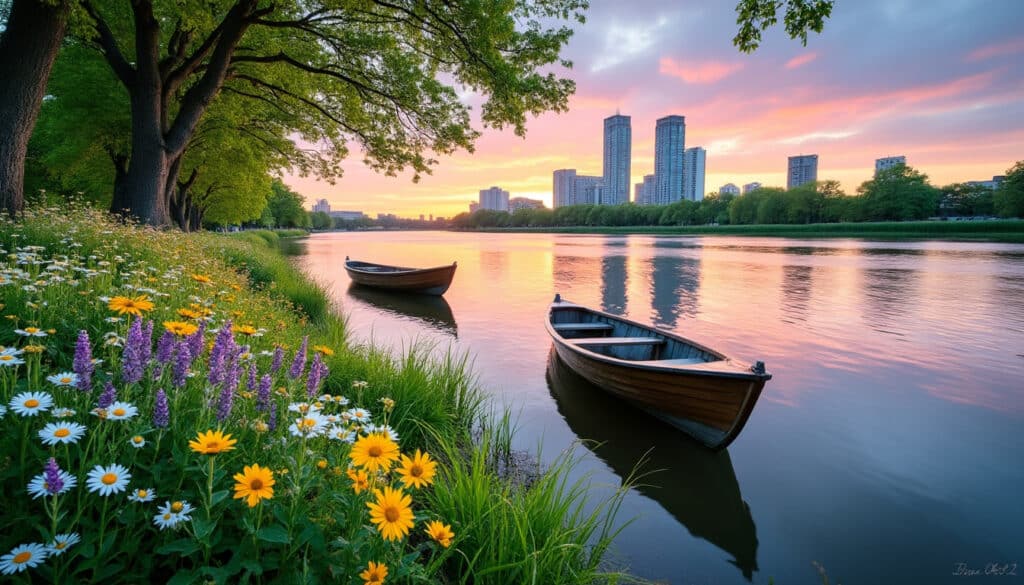Berlin, a city steeped in history and modern dynamism, stands as a masterpiece of geographical contrasts and cultural mosaics. Nestled in the northeast of Germany, the capital city is framed by the lush forests and waterways that soften its urban edges. Amidst these natural settings, Berlin emerges not only as a political epicenter but also as a cultural and ecological marvel, intertwining the legacy of its storied past with a vibrant present. Let’s explore the unique geographical features that define Berlin and contribute to its distinctive character.
Berlin’s Iconic Waterways: The Spree and Havel Rivers
At the heart of Berlin’s geographical layout lies the Spree River, a key feature that shapes both the city’s landscape and cultural life. Flowing through the metropolis, the Spree River is more than just a body of water; it’s a historical thread that weaves through Berlin’s diverse districts. The river is renowned for its scenic banks and the vibrant life that animates them, offering a picturesque backdrop for Berlin’s blend of contemporary and historical architecture.
The Spree, along with its companion, the Havel River, carves a network of navigable routes that have historically facilitated trade and movement. As such, Berlin’s waterways have been crucial to its growth and development. The Havel River, a tributary of the Elbe, is particularly famous for the picturesque lakes it forms in western Berlin, such as Lake Wannsee, a popular recreational spot.
Moreover, these waterways contribute significantly to Berlin’s ecological sustainability. They support a diverse range of wildlife and offer numerous recreational opportunities for residents and tourists alike. Boat tours along the Spree are a favored way to experience the city from a unique perspective, providing insights into its iconic sites, such as the notorious Berlin Wall, which once cast its shadow along the riverbanks.
In addition to their aesthetic and recreational roles, the Spree and Havel are vital in moderating the local climate. They help maintain humidity and contribute to cooling the city during the summer. Their presence underscores the balance Berlin achieves between urban development and natural preservation, a relationship nurtured by careful urban planning and environmental respect.

This harmonious coexistence of water and cityscape is accentuated at places like Potsdamer Platz, a hub where modern architecture meets historical significance, offering a glimpse into Berlin’s constant evolution. The rivers, together with Berlin’s myriad canals, make up an integral part of the city’s ecological and cultural framework, ensuring that water remains at the core of Berlin’s identity.
Understanding Berlin’s waterways provides not only a lesson in geography but also an engaging journey into the city’s heart and soul. The rivers are an enduring testament to Berlin’s resilience and innovation, shaping the city into a harmonious blend of history and modernity. Whether viewed from a historical or contemporary perspective, the Spree and Havel rivers continue to be pivotal in defining Berlin’s geographical and cultural landscape.
The Diverse Climatic Influences on Berlin’s Environment
Berlin’s unique climate plays a crucial role in shaping its geographical features and urban life. Positioned where the Atlantic Ocean’s influence wanes and the continental climate begins, Berlin experiences distinctive seasonal variations that define its character. The city’s temperate climate is marked by cold winters and warm summers, offering a dynamic backdrop for the diverse array of outdoor and cultural activities that flourish here.
The winters in Berlin are often frosty, with temperatures occasionally dropping below zero degrees Celsius. Snowfall is a common occurrence, transforming the cityscapes into a winter wonderland and providing opportunities for seasonal sports at locations like the famously molded Teufelsberg hill. This man-made peak, created from wartime rubble, also serves as a reminder of Berlin’s resilience and capacity to reinvent itself.
Conversely, summers present a vibrant contrast with warm, sunny days that invite residents and tourists to explore Berlin’s vast parks and lake regions. The Tiergarten, one of the city’s largest and most beloved parks, comes alive with picnics, festivals, and open-air concerts, while lakes such as Lake Müggelsee provide a refreshing retreat from the bustling urban environment.
Berlin’s varied climate also contributes to a rich biodiversity. The seasonal shifts create diverse ecosystems within the city that support an array of fauna and flora. This is complemented by the city’s commitment to preserving green spaces and integrating nature into urban planning, ensuring that Berlin can boast a living harmony between nature and city life.
Another aspect influenced by Berlin’s climate is its architecture. Buildings such as the iconic Reichstag Building have been designed to not only endure the temperature extremes but also harness them to reduce energy consumption. This building, among others, exemplifies Berlin’s fusion of aesthetic and functional design, marrying historical significance with modern ecological practices.
An interactive synthesis of climate and culture is evident in the city’s dynamic festivals and events. The weather conditions often dictate the timing and nature of these cultural gatherings, ensuring that they are as diverse and vibrant as the city itself. Whether it’s the frosty allure of the Berlin Film Festival in winter or the sunlit splendor of the Berlin Marathon in autumn, climate influences are omnipresent, shaping Berlin’s unique cultural rhythm.
Ultimately, Berlin’s climate does more than just define its seasons. It influences the way Berliners live, adapt, and celebrate their city, creating a tapestry of life that is as varied and vibrant as the weather itself. In Berlin, climate is not just an atmospheric condition; it’s a cultural and ecological catalyst that touches every facet of the city’s existence.
Forests and Parks: The Green Lungs of Berlin
An exploration of Berlin’s geographical features would be incomplete without highlighting its verdant spaces, often referred to as the city’s “green lungs.” These expansive natural areas are crucial to the urban landscape, providing both ecological benefits and recreational opportunities that enhance the quality of life for residents and visitors alike.
Approximately one-third of Berlin is composed of forests, parks, and gardens, a testament to its commitment to preserving and integrating nature within the urban framework. Dominated by pine and birch forests, these green zones not only support biodiversity but also serve essential ecological functions. They act as natural carbon sinks, purifying the air and buffering the city from excessive heat during the hotter months.
The Tiergarten, often likened to New York’s Central Park, is one of the most notable of these green areas. Spanning vast acres in the city’s heart, it offers a serene escape filled with beautifully landscaped gardens, monuments, and walking paths. This historical park is a favored spot for leisurely strolls, attracting both locals and tourists seeking respite from the city’s hustle and bustle.
Beyond the Tiergarten, Berlin boasts numerous other parks and wooded areas, such as the Grunewald Forest—a sprawling green space that covers a significant area of the western city and touches the picturesque shores of the Havel River. Nearby, the Charlottenburg Palace, with its meticulously maintained gardens, showcases the harmony of nature and architecture, offering an enchanting glimpse into Berlin’s past.
Noteworthy too is Tempelhofer Feld, a former airport turned public park that epitomizes Berlin’s resourceful use of space. This area offers expansive fields for recreational activities, community gardens, and is a symbol of the city’s capacity for transformation and innovation. Its presence helps maintain ecological balance, supports urban agriculture, and provides a platform for social gatherings and events year-round.
- 🌲 Tiergarten: Central oasis in Berlin
- 🌳 Grunewald: Forest bordering the Havel
- 🏞️ Tempelhofer Feld: Open ground for recreation
- 🌿 Charlottenburg Gardens: Historical elegance
Berlin’s dedication to fostering its green spaces is not limited to aesthetics or recreation. It’s an integral part of the city’s environmental strategy, contributing to climate resilience and promoting sustainability. By valuing these green assets, Berlin demonstrates a forward-looking approach to urban living, balancing growth with ecological mindfulness.
Urban Landscapes and Modern Architecture in Berlin
Berlin is a city where tradition meets modernity, and its architecture embodies this dynamic fusion. The urban landscapes of Berlin are a testament to its complex history and its forward-thinking resilience, with structures ranging from legendary historical sites to groundbreaking modern edifices.
The Brandenburg Gate, an iconic symbol of Berlin’s history, stands as a remnant of the city’s past. It serves not only as a tourist attraction but as a reminder of Germany’s tumultuous journey through history. Nearby, the revitalized Potsdamer Platz captures Berlin’s transformation into a hub of modern architecture, with its impressive skyscrapers and vibrant cultural scene.
Berlin’s urban fabric is further enriched by its multitude of monuments and memorials. The Berlin Wall, once a divisive structure, now serves as a poignant reminder of the city’s division and subsequent reunification. It’s celebrated through installations like the haunting Molecule Man sculpture that stands proudly along the Spree, symbolizing unity in diversity.
This architectural diversity echoes in every district, from the avant-garde buildings in Friedrichshain to the stately structures in Charlottenburg. The latter boasts the magnificently restored Charlottenburg Palace, a splendid example of Baroque architecture, offering a window into the regal past of the city.
| Landmark | Symbolism | Location |
|---|---|---|
| Brandenburg Gate | Unity | Pariser Platz |
| Berlin Wall | History | Various Locations |
| Molecule Man | Unity in Diversity | Spree River |
| Charlottenburg Palace | Regal Heritage | Charlottenburg |
Emphasizing Berlin’s architectural prowess are structures like the Reichstag Building, with its modern glass dome representing transparency and democracy. This blend of old and new within the city exemplifies Berlin’s ethos of embracing change while honoring its legacy.
The urban landscape of Berlin is a continuous canvas, reflecting the ebb and flow of its storied past alongside its ambitious future. As Berlin continues to evolve, its architecture remains a vital narrative device, encapsulating stories of the past while looking forward to new narratives that will be built on its resilient foundations.
The Geological and Topographical Elements Shaping Berlin
Berlin’s foundation lies in its unique geological and topographical features, which have been shaped by natural forces over millennia. The city is primarily set on the sandy glacial soils of the Northern European Plain, offering a landscape characterized by gentle undulations rather than dramatic elevations.
The most prominent of Berlin’s elevations is the Kreuzberg, a hill that reaches 218 feet above sea level, providing panoramic views of the cityscape below. Another significant feature is the Teufelsberg, which towers at 380 feet; this man-made hill was constructed from the rubble of World War II, symbolizing Berlin’s resilience and capacity for regeneration.
Berlin’s geology is further defined by a network of lakes and waterways, shaped during the last Ice Age. These bodies of water, including the Spree and Havel rivers, have played an instrumental role in shaping the city’s development. They have not only supported trade and transportation but have also been integral in establishing Berlin as a cultural and economic hub.
Additionally, the soil composition and topography have influenced urban planning and architecture, dictating the type of building materials used and the structural designs suitable for the city’s foundation. This has been reflected in Berlin’s architectural resilience and the ability to integrate modern infrastructure within its unique geological constraints.
Historical events, too, have left indelible marks on Berlin’s topography. The post-war era saw the city transformed under layers of reconstruction, coupled with innovative planning that utilized existing natural landscapes to create spaces like the Tempelhofer Feld. These transformations have ensured that Berlin remains adaptable and resourceful, deriving strength from its geological legacy.
- 🗻 Kreuzberg Hill: Natural elevation offering city views
- 🏔️ Teufelsberg: A hill born from history
- 💧 Spree and Havel: Lifelines of Berlin
- 🌊 Lakes: Natural cooling systems
Berlin’s geological underpinnings continue to play a pivotal role in its identity, steering the city’s growth and evolution in harmony with its natural environment. This symbiosis is testament to Berlin’s ability to meld the old with the new, creating a cityscape that honors its past while progressing towards a sustainable future.
FAQ
- Why was the Berlin Wall built around West Berlin? The Berlin Wall was erected in 1961 to prevent East Germans from fleeing to democratic West Berlin, symbolizing the broader division between East and West during the Cold War.
- What type of climate does Berlin have? Berlin has a temperate seasonal climate with cold winters and warm summers, influenced by both Atlantic and continental weather patterns.
- What are some of Berlin’s famous cultural institutions? Berlin is renowned for institutions such as Museum Island, the Berlin Philharmonic, and the East Side Gallery, reflecting its rich cultural heritage.
- What country is Berlin the capital of? Berlin is the capital city of Germany, located in the northeastern part of the country.
- How does Berlin balance urban development with natural preservation? Berlin integrates extensive green spaces, water management, and sustainable urban planning to ensure a balance between development and nature.

Nature and Geography of Berlin
As one of Europe’s most vibrant cities, Berlin boasts a unique blend of history, culture, and modernity. However, beyond its urban allure, Berlin offers an exceptional geographical landscape intertwined with nature. Known for its vast parks, tranquil lakes, and the…

Location and coordinates of Berlin
Berlin is more than just the capital of Germany; it’s a city rich with history, culture, and an unmistakable vibe that attracts millions each year. Understanding Berlin’s location and its geographic coordinates is essential for anyone looking to truly explore…

Berlin, renowned for its vibrant urban life and rich history, holds a hidden treasure that few might expect from a bustling metropolis: an abundant tapestry of nature and wildlife. The city is home to a plethora of natural wonders, from…


